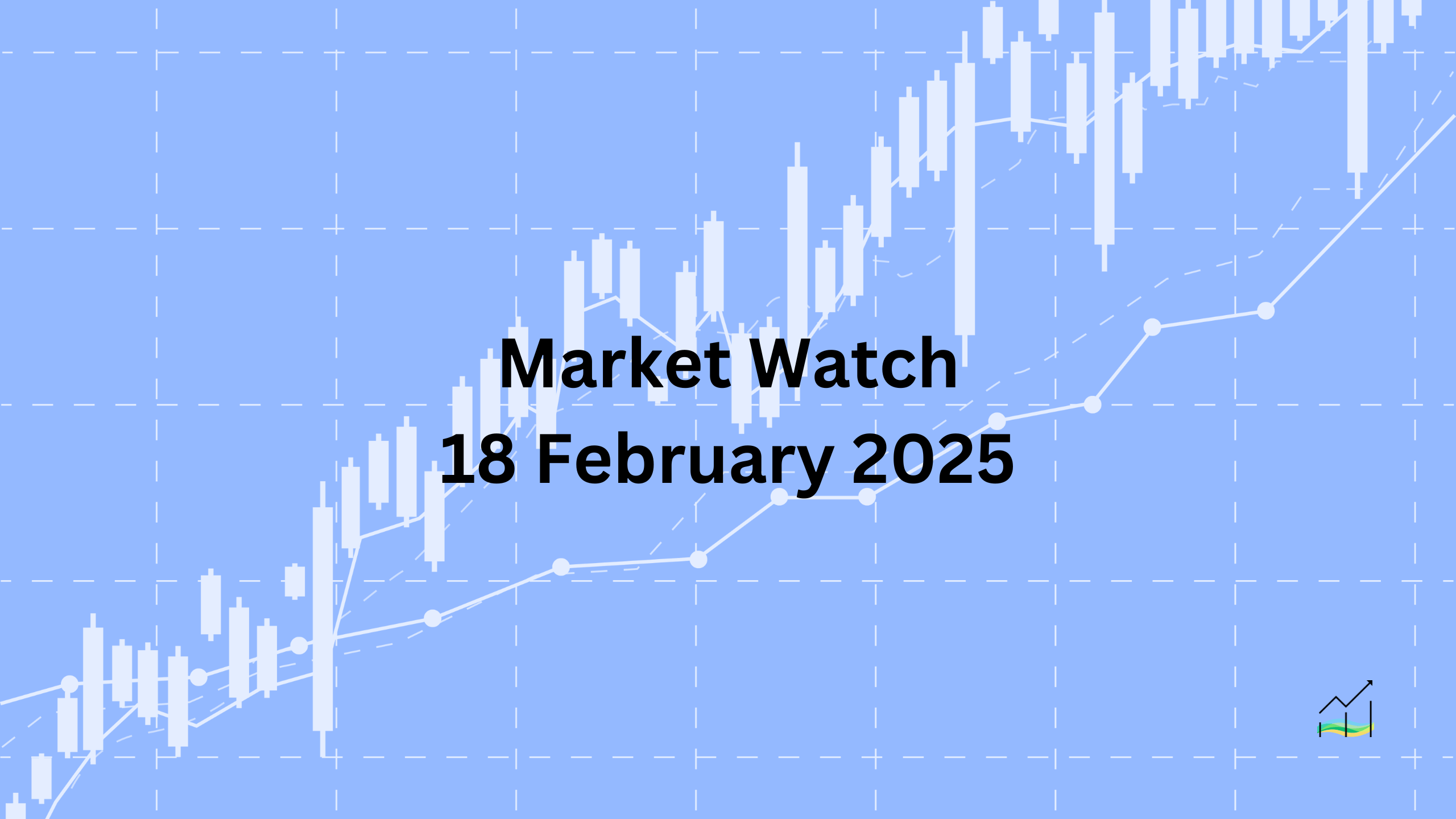18/02/2025 Market Watch

USD Strengthens as Central Bank Moves
The US dollar maintains a firmer tone against most G10 currencies in a relatively quiet session. Despite the Reserve Bank of Australia's decision to start its easing cycle, the Australian dollar is holding steady, as the central bank delivered a more hawkish cut than expected. Futures markets have now pushed expectations for the next cut to August. In the UK, stronger wage growth and an increase in employment for the first time in three months failed to support the pound, which remains under pressure. Meanwhile, the New Zealand dollar is the weakest among major currencies, down nearly 0.50%, as the Reserve Bank of New Zealand is widely expected to implement its third consecutive half-point rate cut. Among emerging markets, most Asian and Central European currencies are softer, while the Mexican peso leads with a modest 0.20% gain.
Equities present a mixed picture. Tokyo, Hong Kong, and Taiwan saw gains, while profit-taking weighed on Chinese markets. Australian and New Zealand equities declined. In Europe, the Stoxx 600 is flat, while US futures are slightly positive. Bond yields are mixed, with European benchmark 10-year yields fluctuating narrowly. UK Gilts yield is up nearly two basis points, while the US 10-year Treasury yield has edged back above 4.50% following last week’s decline.
Commodities are showing strength, with gold recovering from recent losses and establishing support above $2900. After dropping 1.5% before the weekend, gold climbed 0.5% yesterday and continues to rise. Oil prices are firmer, supported by speculation that OPEC may delay its planned output increase. April WTI crude held support near $70, this year's low, and has now approached $72.
United States of America
Overview
The Dollar Index is set to break its five-day losing streak, which had taken it to a two-month low. Despite higher-than-expected US CPI and PPI data, markets still anticipate a decline in the Fed’s preferred inflation measure. Additionally, weak retail sales have weighed on the dollar. The recent pullback is nearing key technical levels, suggesting a potential reversal.
Economic Drivers
The dollar’s recent decline began after reaching a peak just below 110.20, before falling to 106.55 at the end of last week. The move lower aligns with broader market expectations that inflation pressures may ease, allowing the Fed to maintain a patient stance on monetary policy. However, no immediate changes are expected at next month’s FOMC meeting, where attention will be on the updated Summary of Economic Projections.
Data and Events
Today's economic releases include the NY Fed’s Empire State manufacturing survey and TIC data. While these reports typically do not drive major market moves, comments from Fed officials, including President Daly and Governor Barr, may provide additional insights. So far, there appears to be a strong consensus within the Fed to remain on hold.
Price Action
The downside correction in the Dollar Index appears well-advanced. The 106.35 level represents the 38.2% retracement of the rally from last September’s low. The index reached 107.05 today, and a move above 107.30 could signal that the recent pullback is over, reinforcing a potential recovery.
Key Points:
- The Dollar Index is rebounding after a five-day decline, which brought it to a two-month low.
- Higher-than-expected inflation data and weak retail sales pressured the greenback.
- The Fed is expected to hold rates steady at next month’s meeting, with focus on its updated projections.
- Today’s economic releases include the NY Fed’s survey and TIC data, but neither is expected to be a major market mover.
- Key technical levels to watch: 106.35 as support, 107.30 as potential confirmation of a reversal.
Australia
Overview
The Reserve Bank of Australia (RBA) officially started its easing cycle today with a widely expected 25 bp rate cut, bringing the cash rate target to 4.10%. Despite this move, the central bank maintained a cautious tone, leading markets to push expectations for the next cut to August.
Economic Drivers
Australia’s two-year yield discount to the US recently widened to nearly 55 bp, the highest since last July, before narrowing to around 35 bp. This shift reflects expectations that the RBA’s policy divergence with the Federal Reserve will continue in the coming months.
Data and Events
The rate cut was fully anticipated, and the RBA’s messaging suggests a measured approach to further easing. With the next cut not yet fully priced in until August, traders will closely monitor upcoming inflation and labor market data for further clues.
Price Action
The Australian dollar reached a two-month high near $0.6375 yesterday but has struggled to break above that level today. Earlier weakness saw it dip to $0.6335 before recovering. A key technical level to watch is $0.6415, the 38.2% retracement of the currency’s decline since last September’s high near $0.6940.
Key Points:
- The RBA cut rates by 25 bp to 4.10%, beginning its easing cycle.
- Markets expect the next rate cut in August, reinforcing a cautious outlook.
- Australia’s two-year yield discount to the US has narrowed from 55 bp to 35 bp.
- The Australian dollar tested $0.6375 but remains below this key resistance level.
- $0.6415 is a key retracement target to watch for further gains.
Canada
Overview
The US dollar has fallen sharply against the Canadian dollar, dropping about 4.35% from its February 3 high near CAD1.48 to a pre-weekend low around CAD1.4150. However, the decline may be nearing exhaustion, with key resistance levels in focus.
Economic Drivers
Despite recent weakness, the US dollar could regain footing if it moves above CAD1.4230-40, with stronger confirmation near CAD1.4260. The broader outlook remains influenced by potential US tariffs, which could have economic consequences for Canada beyond near-term inflation trends.
Data and Events
Canada releases its January CPI data today. Inflation was flat on an annualized basis in Q4 2024, following a 0.8% decline in Q3. A slight increase of 0.1% in January is expected, which would push the year-over-year rate to 1.9% from 1.8%. Core inflation measures may also rise slightly, but the Bank of Canada’s focus could shift toward potential economic fallout from US trade policies.
Price Action
The greenback briefly tested CAD1.42 in Asia Pacific trading but remains below this level in European hours. A move above CAD1.4230-40 would indicate a potential reversal, with CAD1.4260 as a key level to confirm a recovery.
Key Points:
- The US dollar has declined 4.35% against the Canadian dollar since February 3.
- A recovery above CAD1.4230-40, and ideally CAD1.4260, would signal stabilization.
- Canada’s CPI is expected to rise slightly, with the year-over-year rate moving to 1.9%.
- The Bank of Canada may focus more on potential US tariffs rather than near-term inflation.
- The US dollar remains below CAD1.42 in European trading, with key resistance levels ahead.
China
Overview
The US dollar initially weakened against the offshore yuan (CNH), reaching a new monthly low near CNH7.2425 before recovering to session highs around CNH7.2680. The rebound continued today, with the dollar climbing to nearly CNH7.2865 amid broad-based strength.
Economic Drivers
Since returning from the Lunar New Year holiday, the People's Bank of China (PBOC) has maintained a tight range for the yuan’s reference rate, setting it between CNY7.1691 and CNY7.1719. This controlled approach highlights efforts to stabilize the currency. Meanwhile, China’s bond market has seen shifts, with the 10-year yield discount to US Treasuries narrowing from a record 315 basis points in mid-January to around 280 basis points, the smallest gap since mid-December.
Data and Events
The Chinese stock market has been a standout performer, with the index of mainland shares listed in Hong Kong rallying approximately 16.25% so far this year, making it one of the strongest global markets. The PBOC’s daily fixings remain in a narrow range, reinforcing stability in the yuan's official exchange rate.
Price Action
After testing CNH7.2425, the US dollar rebounded sharply and now approaches CNH7.2865. Market focus remains on whether the greenback can sustain its upward momentum or if the PBOC’s policies will contain further appreciation.
Key Points:
- The US dollar fell to CNH7.2425 before rebounding to CNH7.2865.
- The PBOC has set the yuan’s reference rate in a narrow range post-Lunar New Year.
- China’s 10-year yield discount to US Treasuries has narrowed to 280 basis points.
- Chinese stocks in Hong Kong have surged 16.25% this year, among the best global performers.
- The dollar’s next move depends on market momentum and PBOC intervention.
Europe
Overview
The euro has struggled to break above key resistance levels, with January’s high at $1.0535 and last week's peak at $1.0515 possibly marking February’s high. Support near $1.0450 has been tested, and a break below this level could weaken the technical outlook after last week's 1.6% gain.
Economic Drivers
Germany's ZEW survey showed some improvement. The current situation assessment rose for the second consecutive month to -88.5, though it remains deep in negative territory. The lowest reading was -93.1 in December 2024, close to the pandemic low of -93.5. The expectations component, which has alternated between gains and losses since last September, increased from 10.3 in January to 26.
Data and Events
The ZEW survey results suggest cautious optimism but still highlight persistent economic struggles. The market continues to assess the euro’s outlook in light of these economic indicators and broader macroeconomic trends.
Price Action
The euro’s resistance at $1.0515 and potential support at $1.0450 remain key levels to watch. A break above $1.0550, which aligns with the 38.2% retracement of the euro’s downtrend from last September’s high of $1.1215, would indicate further upside potential. However, failure to hold above support could shift momentum downward.
Key Points:
- The euro’s recent high at $1.0515 may be February’s peak.
- Support at $1.0450 is critical; a break below could weaken the technical outlook.
- Germany’s ZEW survey showed slight improvement, though economic sentiment remains weak.
- The 38.2% retracement level at $1.0550 is a key resistance point.
- Price movement depends on economic data and market sentiment toward the euro.
Japan
Overview
The dollar has extended its pullback against the yen for three consecutive sessions, influenced by a combination of declining US 10-year yields and stronger-than-expected Japanese economic data. The pair dropped to JPY151.35 yesterday before making a marginal new low at JPY151.25 today, later recovering as US yields firmed.
Economic Drivers
Two primary factors continue to shape the dollar-yen exchange rate: movements in the US 10-year yield and expectations surrounding the Bank of Japan’s (BOJ) policy shift. The dollar’s earlier decline was linked to a nearly 15 basis point drop in US yields. Additionally, Japan’s stronger Q4 GDP growth of 2.8% (double the expected rate) and an upward revision of Q3 GDP to 1.7% from 1.2% increased confidence that the BOJ will move toward policy normalization.
Data and Events
Japan will release its January trade figures tomorrow. Historically, January trade deficits are a given, with 30 consecutive years of deterioration in that month. While Japan maintains an overall trade deficit, it recorded a $68.5 billion trade surplus with the US in 2024.
Price Action
The dollar remains below yesterday’s high of JPY152.40. A break above this level would target JPY153.00, while continued downside pressure could keep it near JPY151.25-151.35.
Key Points:
- The dollar-yen pair has declined for three sessions, reaching a low of JPY151.25.
- Declining US 10-year yields contributed to the move.
- Japan’s stronger-than-expected Q4 GDP (2.8%) reinforced BOJ normalization expectations.
- Japan’s January trade data will be released tomorrow; deficits are historically typical.
- Resistance stands at JPY152.40, with an upside target of JPY153.00.
United Kingdom
Overview
Sterling traded within a narrow range around $1.26 yesterday, reaching a marginal new two-month high near $1.2640 in thin post-European trading. The currency remains within yesterday’s range today, with key levels at $1.2580 on the downside and resistance near $1.2610, where the 38.2% retracement of its decline from September’s high ($1.3435) is found.
Economic Drivers
UK employment data showed stronger wage growth, with regular private sector pay rising to 6.2% in Q4 2024, up from 5.9% (previously revised from 6.0%). The number of payrolled employees increased for the first time in three months, while the ILO unemployment rate remained at 4.4%, a cyclical high. However, jobless claims rose by 22, indicating ongoing labor market challenges.
Data and Events
The market is focused on tomorrow’s UK CPI report, which will provide further insight into inflation trends. Expectations for the Bank of England’s (BOE) policy remain stable, with the swaps market assigning little chance of a rate cut next month but pricing in over a 90% probability of a cut at the May 8 meeting.
Price Action
Sterling is consolidating inside yesterday’s range. A break above $1.2640 could target the next retracement level at $1.2765-90, which also aligns with the 200-day moving average. On the downside, initial support lies at $1.2580, with further support around $1.2550.
Key Points:
- Sterling hit a two-month high near $1.2640 but remains within yesterday’s range.
- Key resistance is at $1.2610 (38.2% retracement), with $1.2765-90 as the next target.
- UK employment data showed stronger wage growth and a rise in payrolled employees.
- The ILO unemployment rate stayed at 4.4%, while jobless claims increased.
- The BOE is unlikely to cut rates next month, but a May rate cut is 90% priced in.
- Tomorrow’s CPI report is the next key event for market direction.
© 2025 SKONE Enterprise (003319453-V). All rights reserved.
The content on this site is for informational purposes only and does not constitute financial advice.


